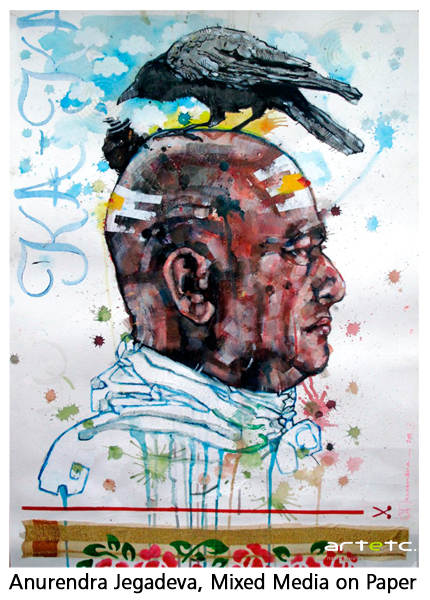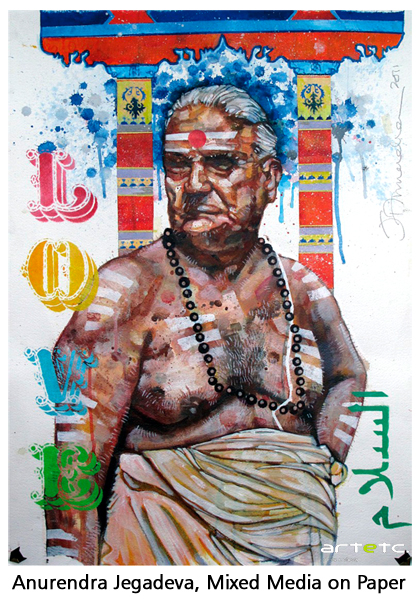- Publisher’s Note
- Editorial
- Progressive Artists Group of Bombay: An Overview
- S. H. Raza: The Modern
- Ara: The Uncommon Commoner
- Art of Francis Newton Souza:A Study in Psycho-Analytical Approach
- M.F. Husain: An Iconoclastic Icon
- Husain’s ‘Zameen’
- Life and Art of Sadanand Bakre
- Hari Ambadas Gade: Relocating the Silent Alleys
- Mysticism Yearning for the Absolute
- Modernist Art from India at Rubin Museum of Art, New York
- Traditional Art from India at the Peabody Essex Museum
- Nandan Mela 2011: A Fair with Flair
- India's First Online Auction of Antiquities
- The Market Masters
- Markets May Plunge and the Rich May Flock To Art
- What Happened and What's Forthcoming
- Random Strokes
- Julian Beever: Morphing Reality With Chalk Asthetics
- Eyes on Life: Reviewing Satish Gujral’s Recent Drawings
- Exploring Intimacy: Postcards of Nandalal Bose
- Irony as Form
- Strange Paradise
- Eyeball Massage: Pipilotti Rist
- René Lalique: A Genius of French Decorative Art
- The Milwaukee Art Museum – Poetry in Motion
- 9 Bäumleingasse
- Art Events Kolkata: November – December 2011
- Art Bengaluru
- Mumbai Art Sighting
- Delhi Dais
- Tacita Dean at Turbine Hall, Tate Modern, London
- Preview: January, 2012 – February, 2012
- In the News: December 2011
ART news & views
Strange Paradise
Issue No: 24 Month: 1 Year: 2012
Review
by Nalini S Malaviya



Bangalore. Strange Paradise - Memories of Empire, the Gods and Mulligatawny Soup reads the title of the exhibition at Gallery Sumukha, which features works by the Malaysian artist, Anurendra Jegadeva. A strange title, one realizes but definitely intriguing.
The exhibits can be broadly classified as four separate works – Portrait of my Mother as the Queen, The Post Colonial Alphabet, This Is Where We Live and the Navagraha series. Jegadeva’s art deals with socio-political and cultural issues resulting from post-colonialism and immigrant life and associated paradoxes and conflicts. There is a strong sense of an autobiographical approach in his works. The 1965 born artist of Indian descent, has lived and worked in both Malaysia and Australia. The title of the exhibition aptly describes the dichotomy and the disparity that arises in a multicultural environment where there are deep breaches between aspirations and ground realities. Jegadeva’s works accentuate a society concerned with multiple issues and striving hard to resolve the complexities and anxiety resulting from a troubled past and a promising future.
Adopting a narrative style, there is a layering of symbols and metaphors in the construction of the image. For instance, The Post Colonial Alphabet is a mixed media work comprising of 26 miniature panels, which are both witty and satirical. Juxtaposing images of icons against those of everyday life to create new contextual frameworks, the works define and describe the aspirational and paradoxical society of Malaysia. The series on the Navagrahas portrays nine priests with an attempt to highlight the intrinsic quality and characteristics of each graham and their perception and significance to people. The press release explains that Jegadeva constantly resorts to ‘recurring motifs, colour symbolism, the framing devices of temple carvers and stained glass makers, and comic book artists - the vocabulary of a multifarious existence’.
There are strong political and religious undercurrents in his works, perhaps a reflection of the environment in his country. In the exhibition, displayed here in Bangalore, there is an effort to highlight or an attempt to reconcile the traditional with modernity, to bring out cultural nuances and essentially to draw attention to the current state of affairs. And, to emphasize how multiple issues come together and collide in contemporary society. His style of narration is strong and put forth dominantly which also tends to underline his own stance and search for identity amidst the contemporary scene.
The comic book approach which is adopted at times and the elaborate framing technique which is used, oscillate between a sense of the absurd and the severe – a delightful straddling between extremities. However, the generous spattering of paint on most of his paper works can be distracting for the viewer.
Jegadeva is showing his works in India for the fist time and one is a little uncertain about the kind of response it is likely to generate here. But it must be mentioned that the images and metaphors that he uses are universal and easily recognizable in most South Asian countries and to a large extent even in the West.